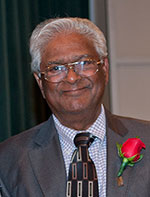Sanjaya Rajaram

Lecture Title: "Global Food and Nutrition Security"
About the guest speaker
In a time of public debate over the efficacy and safety of genetically modified foods, it’s hard to picture the era before crop breeders developed grain varieties that could withstand drought and common diseases.
These hardy and productive crops helped double and, in some cases, triple food production in developing nations, saving millions of lives.
Sanjaya Rajaram was awarded the World Food Prize in 2014 in recognition of his work as a wheat breeder, which resulted in a 200-million-ton rise in the global annual wheat harvest and increased food security in 51 countries. He championed the free trade of plant breeding information and technology around the globe, further contributing to the development of stress-resistant varieties of wheat and other grains.
Rajaram was born in 1943 near a small farming village in the state of Uttar Pradesh in northeastern India, four years before the country won its independence from Britain. His family, including his parents, an older brother and a younger sister, made a meager living on their 5-hectare (more than 12 acres) farm growing wheat, rice and maize.
Recognizing that Rajaram was keenly interested in learning about the world around him, his parents sent him to primary and secondary schools in a village 5 kilometers (about 3 miles) away from his home. This was at a time when roughly 96 percent of the rural population of India had no formal education. He continued on to college and graduate school, receiving his doctoral degree from the University of Sydney.
Rajaram’s research and field work began at the International Maize and Wheat Improvement Center (CIMMYT) in 1969, working with Norman Borlaug in the fields of El Batán, Mexico. In 1972, Borlaug asked Rajaram to succeed him and head up the wheat breeding team at CIMMYT.
He implemented a major expansion of Borlaug’s ingenious shuttle-breeding approach in countries beyond Mexico, emphasizing wide adaptation of new plants to differing climate and soil conditions; superior grain quality; and increasing the resistance to diseases and pests that had devastated farmers’ crops. This shuttle-breeding technique involved growing two successive plantings each year in northern and southern latitudes, which produced two test generations of wheat each year instead of one, cutting in half the years required for research and breeding new varieties.
Rajaram significantly advanced his mentor’s work in improving wheat varieties during a period that has been described as the “golden years” of wheat breeding and production.
In addition to increasing the world’s production of wheat, Rajaram’s new varieties reached into marginal areas, such as small mountain plots in Pakistan and remote areas in China. He also developed cultivars with durable resistance to rusts—the most damaging disease to wheat worldwide.
Realizing the importance of freely sharing knowledge to provide developing countries with the ability to grow more food, Rajaram launched efforts to expand the global scientific wheat network—a worldwide exchange of genetic resources, information and innovations among researchers—which had not been done before.
This led to the accelerated development and worldwide spread of high-yielding wheat varieties, which has kept the expansion of global wheat production ahead of population growth and made wheat even more accessible to the world’s poor.
Additional resources
- News release:
World Food Prize laureate to give 2015 D.W. Brooks Lecture at UGA - News release:
Supporting small farmers is the key to boosting world food supply, says World Food Prize winner - Link:
2014 World Food Prize Laureate
